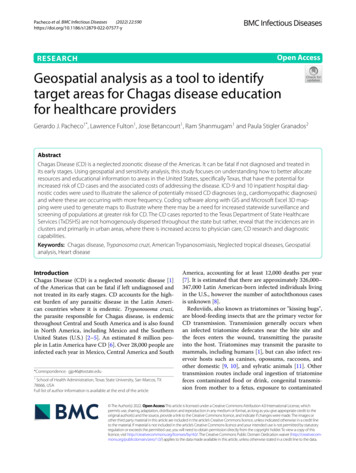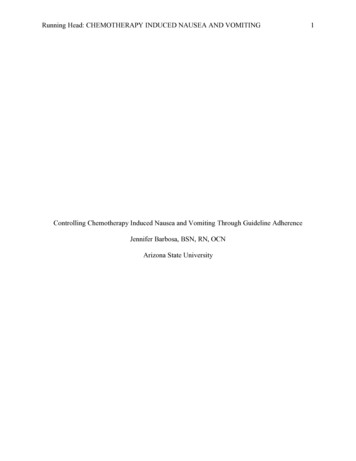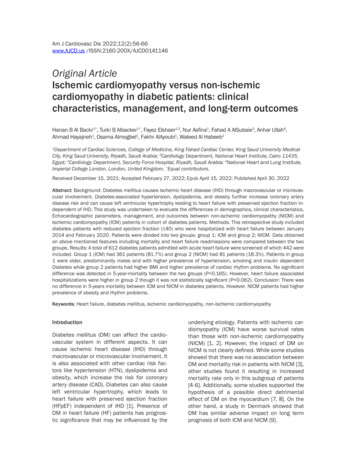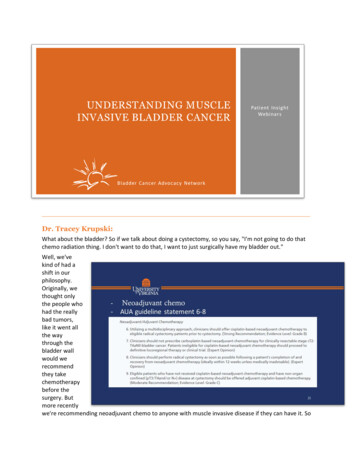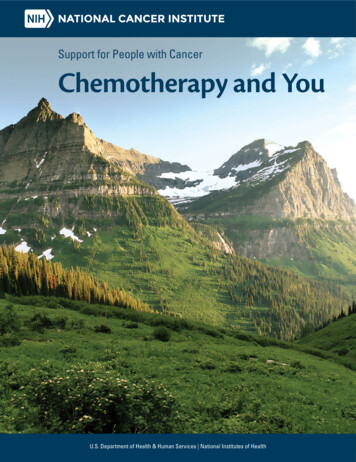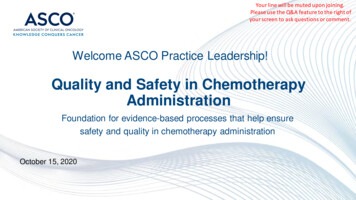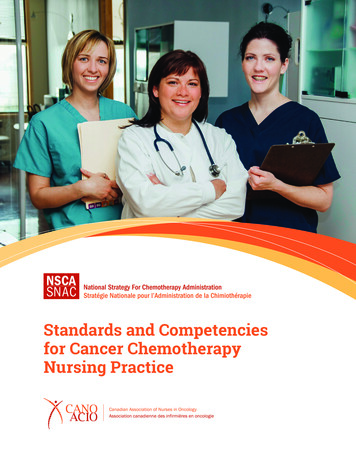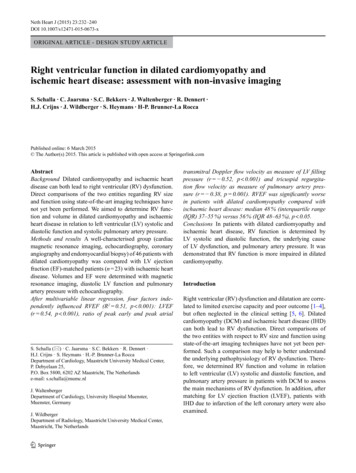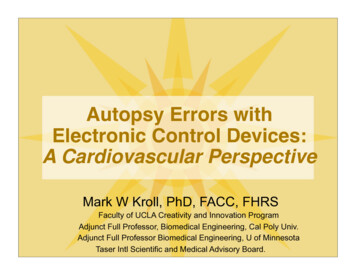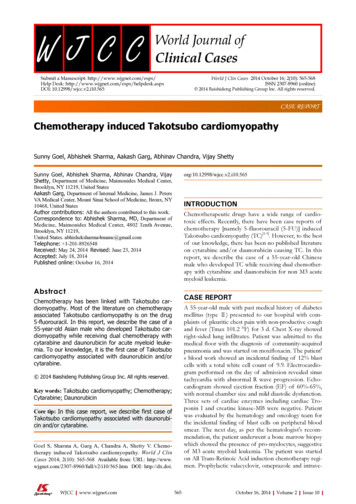
Transcription
WJ CCWorld Journal ofClinical CasesWorld J Clin Cases 2014 October 16; 2(10): 565-568ISSN 2307-8960 (online)Submit a Manuscript: http://www.wjgnet.com/esps/Help Desk: http://www.wjgnet.com/esps/helpdesk.aspxDOI: 10.12998/wjcc.v2.i10.565 2014 Baishideng Publishing Group Inc. All rights reserved.CASE REPORTChemotherapy induced Takotsubo cardiomyopathySunny Goel, Abhishek Sharma, Aakash Garg, Abhinav Chandra, Vijay Shettyorg/10.12998/wjcc.v2.i10.565Sunny Goel, Abhishek Sharma, Abhinav Chandra, VijayShetty, Department of Medicine, Maimonides Medical Center,Brooklyn, NY 11219, United StatesAakash Garg, Department of Internal Medicine, James J. PetersVA Medical Center, Mount Sinai School of Medicine, Bronx, NY10468, United StatesAuthor contributions: All the authors contributed to this work.Correspondence to: Abhishek Sharma, MD, Department ofMedicine, Maimonides Medical Center, 4802 Tenth Avenue,Brooklyn, NY 11219,United States. abhisheksharma4mamc@gmail.comTelephone: 1-201-8926548Received: May 24, 2014 Revised: June 23, 2014Accepted: July 18, 2014Published online: October 16, 2014INTRODUCTIONChemotherapeutic drugs have a wide range of cardiotoxic effects. Recently, there have been case reports ofchemotherapy [namely 5-fluorouracil (5-FU)] inducedTakotsubo cardiomyopathy (TC)[1-5]. However, to the bestof our knowledge, there has been no published literatureon cytarabine and/or daunorubicin causing TC. In thisreport, we describe the case of a 55-year-old Chinesemale who developed TC while receiving dual chemotherapy with cytarabine and daunorubicin for non M3 acutemyeloid leukemia.AbstractCASE REPORTChemotherapy has been linked with Takotsubo cardiomyopathy. Most of the literature on chemotherapyassociated Takotsubo cardiomyopathy is on the drug5-fluorouracil. In this report, we describe the case of a55-year-old Asian male who developed Takotsubo cardiomyopathy while receiving dual chemotherapy withcytarabine and daunorubicin for acute myeloid leukemia. To our knowledge, it is the first case of Takotsubocardiomyopathy associated with daunorubicin and/orcytarabine.A 55-year-old male with past medical history of diabetesmellitus (type Ⅱ) presented to our hospital with complaints of pleuritic chest pain with non-productive coughand fever (Tmax 101.2 F) for 3 d. Chest X-ray showedright-sided lung infiltrates. Patient was admitted to themedical floor with the diagnosis of community-acquiredpneumonia and was started on moxifloxacin. The patient’s blood work showed an incidental finding of 12% blastcells with a total white cell count of 9.9. Electrocardiogram performed on the day of admission revealed sinustachycardia with abnormal R wave progression. Echocardiogram showed ejection fraction (EF) of 60%-65%,with normal chamber size and mild diastolic dysfunction.Three sets of cardiac enzymes including cardiac Troponin I and creatine kinase-MB were negative. Patientwas evaluated by the hematology and oncology team forthe incidental finding of blast cells on peripheral bloodsmear. The next day, as per the hematologist’s recommendation, the patient underwent a bone marrow biopsywhich showed the presence of pro-myelocytes, suggestiveof M3 acute myeloid leukemia. The patient was startedon All Trans-Retinoic Acid induction chemotherapy regimen. Prophylactic valacyclovir, omeprazole and intrave- 2014 Baishideng Publishing Group Inc. All rights reserved.Key words: Takotsubo cardiomyopathy; Chemotherapy;Cytarabine; DaunorubicinCore tip: In this case report, we describe first case ofTakotsubo cardiomyopathy associated with daunorubicin and/or cytarabine.Goel S, Sharma A, Garg A, Chandra A, Shetty V. Chemotherapy induced Takotsubo cardiomyopathy. World J ClinCases 2014; 2(10): 565-568 Available from: URL: m DOI: http://dx.doi.WJCC www.wjgnet.com565October 16, 2014 Volume 2 Issue 10
Goel S et al . Chemotherapy induced Takotsubo cardiomyopathyABFigure 1 Echocardiogram showing ballooning of the apex with hyper contracted basal segment at end systole (A) end diastolic phase (B).ABCFigure 2 Coronary angiogram showing clean coronaries with thrombolysis in myocardial infarction 3 blood flow left main and left anterior descending (A),left circumflex (B) and right coronary artery(C).nous (iv) fluids were also started.Two days after the initiation of chemotherapy, flu orescent in situ hybridization results demonstrated anegative translocation of chromosomes 15, 17, thus confirming the diagnosis of non-M3. As a result, the chemotherapy regimen was changed to cytarabine 100 mg/m2and daunorubicin 60 mg/m2. On day 6 of chemotherapywith cytarabine and daunorubicin, the patient began toexperience non-radiating sub sternal chest pain associatedwith palpitations. Electrocardiogram obtained at that timeshowed sinus tachycardia of 170 bpm with ST segmentelevation in leads I, aVL, V5, V6; consistent with anterolateral wall ST elevation myocardial infarction (STEMI).The patient was transferred to the cardiac intensive careunit (CCU) with a diagnosis of STEMI. Cardiac enzymeswere obtained which showed Cardiac Troponin I of 8.54upon initial transfer to the CCU, reaching a maximum of38.64 after 18 h (normal values 0-0.1 ng/mL). Given thepatient’s immunocompromised state, cardiac catheterization was deferred and he was managed medically withaspirin, clopidogrel, rosuvastatin, and aggressive iv hydration. Echocardiogram done on day 6 of chemotherapyshowed an EF of 30%-35% with segmental wall motionabnormalities: mild anterior, septal, apical, inferior andlateral wall hypokinesia, with normal diastolic functionconsistent with mid-left anterior descending artery occlusion (Figure 1). On day 20 of admission, patientWJCC www.wjgnet.comunderwent an elective cardiac angiogram, which showednon-obstructive coronary vasculature, mildly decreasedleft ventricular systolic function, EF of 50% with mildanterolateral and anterobasal hypokinesia (Figure 2).DISCUSSIONThis case report demonstrates a strong causal relationship between chemotherapy and the development of TCas evidenced in the patient’s presentation on day 6 ofchemotherapy induction. Symptomatic recovery of thepatient after supportive medical management, with theconcomitant discontinuation of the chemotherapeuticagent, also strengthens this causal relationship. The patient’s repeat echocardiogram (performed 2 wk after discontinuation of the chemotherapeutic agents) showed acomplete recovery of the EF with no wall motion abnormalities. In addition, a coronary angiogram demonstratednon-obstructed coronary vasculature. Given the patient’sclinical presentation and the diagnostic evidence obtained,there is no alternative justification for the clinical courseobserved other than Takotsubo cardiomyopathy. This isthe first case report of daunorubicin and/or cytarabineinduced TC.Most of the literature on chemotherapy associatedTC is published on the drug 5-FU, a widely used chemotherapeutic agent for solid tumors. One case report from566October 16, 2014 Volume 2 Issue 10
Goel S et al . Chemotherapy induced Takotsubo cardiomyopathytion abnormalities; cardiac catheterization (two weeks later)-clean coronaries.Pt diagnosed with Takotsubo cardiomyopathy.Japan described daunorubicin-induced TC in a patientwith refractory multiple myeloma[6]. However, to ourknowledge, this is the first case report of daunorubicinand/or cytarabine induced TC in the United States.Chemotherapy induces increased sympathetic tonewith resulting elevation of cytokine, free radical, prostaglandin, catecholamine and growth factor levels. Theexcess of these modulators can potentiate worseningadrenoreceptor sensitivity, and can contribute to the clinical presentation of TC [1-5]. Daunorubicin belongs to theanthracycline class of chemotherapeutic agents, which remains among the most active anti-cancer drugs for solidtumor and hematologic malignancies. The exact pathogenic mechanisms responsible for the underlying cardiotoxic effects of anthracycline agents has yet to be elucidated. The current postulated mechanism supports therole of free radical induced cardiac damage (known tobe caused by the excessive production of hydrogen peroxide, hydroxyl radicals and reactive oxygen species)[6-10].These free radicals promote lipid peroxidation whichcontributes to cell membrane damage, and thus resultsin the activation of pro-apoptotic enzymes, such as Bax,Cytochrome-c and caspase-3, in myocyte mitochondria,triggering apoptosis and resulting in cardiac myocyte celldeath[6-10]. Cardiac myocytes are more susceptible to lipidperoxidation due the presence of a high mitochondrialdensity with resultant high-energy requirements and thelack of anti-oxidant enzymes, which are required for thedetoxification of superoxide anions and hydrogen peroxide. As a result of this cardiac myocyte susceptibility,a dose-related and irreversible loss of cardiac myocytesoccurs, resulting in cardiomyopathy[11]. Though the exactmechanism of cardiotoxicity caused by cytarabine has yetto be elucidated, it is postulated that this drug can resultin a hypersensitivity reaction or possible immune-mediated damage of cardiac myocyte[12].In conclusion, we suggest that physicians be vigilantwhen treating patients with daunorubicin and/or cytarabine and should be aware of a possible association ofthese chemotherapeutic agents with TC.TreatmentDue to patient’s immunocompromised state, he was medically managed withaspirin, clopidogrel, rosuvastatin, and aggressive intravenous hydration in cardiac intensive care unit.Related reportsPatient initially thought to have acute coronary syndrome but was eventuallyfound to have Takotsubo cardiomyopathy. Patient had clean coronaries on Cardiac catheterization and on repeat ECHO, his EF normalized and wall motionabnormalities resolved.Term explanationNon M3 AML-According to French-American-British classification acute myeloidleukemia are sub grouped in to 8 categories M0-M7. This classification guidesthe therapy and prognosis in patients diagnosed with AML.Experiences and lessonsVigilance should be observed while treating patients with daunorubicin and/orcytarabine.Peer reviewThis is first case report of takotsubo cardiomyopathy associated with daunorubicin and/or cytarabine.REFERENCES1234567COMMENTSCOMMENTSCase characteristicsA 55-year-old male receiving treatment with Daunorubicin and Cytarabine fornon M3 acute myeloid leukemia (AML) experience non-radiating sub sternalchest pain associated with palpitations on 6th day after chemotherapy.8Clinical diagnosisAcute coronary syndrome.Differential diagnosis9ST segment elevation myocardial infarction (STEMI), non-STEMI, Unstable Angina, Aortic Dissection, Pulmonary embolism, cardiomyopathy, Ventricular wallrupture.Laboratory diagnosisCardiac troponin I and creatine kinase-MB elevation with continued uptrend,consistent with myocardial ischemia.10Electrocardiogram-anterolateral STEMI; Echocardiogram (ECHO) at day 6 oftherapy-ejection fraction (EF) of 30%-35% with segmental wall motion abnormalities; repeat ECHO (two weeks later)-Normalization of EF and no wall mo-11Imaging diagnosisWJCC www.wjgnet.com567Pai VB, Nahata MC. Cardiotoxicity of chemotherapeuticagents: incidence, treatment and prevention. Drug Saf 2000;22: 263-302 [PMID: 10789823 DOI: 10.2165/00002018-200022040-00002]Smith SA, Auseon AJ. Chemotherapy-induced takotsubocardiomyopathy. Heart Fail Clin 2013; 9: 233-242, x [PMID:23562124 DOI: 10.1016/j.hfc.2012.12.009]Y-Hassan S, Tornvall P, Törnerud M, Henareh L. Capecitabine caused cardiogenic shock through induction of globalTakotsubo syndrome. Cardiovasc Revasc Med 2013; 14: 57-61[PMID: 23218901 DOI: 10.1016/j.carrev.2012.10.001]Grunwald MR, Howie L, Diaz LA. Takotsubo cardiomyopathy and Fluorouracil: case report and review of the literature.J Clin Oncol 2012; 30: e11-e14 [PMID: 22147738 DOI: 10.1200/JCO.2011.38.5278]Stewart T, Pavlakis N, Ward M. Cardiotoxicity with 5-fluorouracil and capecitabine: more than just vasospastic angina. Intern Med J 2010; 40: 303-307 [PMID: 20529041 DOI:10.1111/j.1445-5994.2009.02144.x]Mitsumori T, Nakajima K, Nozaki Y, Hamanaka S, Nagashima T, Kirito K, Iwao N, Komatsu N. [Multiple myelomacomplicated with Takotsubo cardiomyopathy]. Rinsho Ketsueki 2010; 51: 291-296 [PMID: 20467228]Gewirtz DA. A critical evaluation of the mechanisms ofaction proposed for the antitumor effects of the anthracycline antibiotics adriamycin and daunorubicin. BiochemPharmacol 1999; 57: 727-741 [PMID: 10075079 DOI: 10.1016/S0006-2952(98)00307-4]Chua CC, Liu X, Gao J, Hamdy RC, Chua BH. Multiple actions of pifithrin-alpha on doxorubicin-induced apoptosisin rat myoblastic H9c2 cells. Am J Physiol Heart Circ Physiol2006; 290: H2606-H2613 [PMID: 16687611 DOI: 10.1152/ajpheart.01138.2005]Childs AC, Phaneuf SL, Dirks AJ, Phillips T, LeeuwenburghC. Doxorubicin treatment in vivo causes cytochrome Crelease and cardiomyocyte apoptosis, as well as increasedmitochondrial efficiency, superoxide dismutase activity,and Bcl-2: Bax ratio. Cancer Res 2002; 62: 4592-4598 [PMID:12183413]Wang GW, Klein JB, Kang YJ. Metallothionein inhibits doxorubicin-induced mitochondrial cytochrome c release andcaspase-3 activation in cardiomyocytes. J Pharmacol Exp Ther2001; 298: 461-468 [PMID: 11454906]Goormaghtigh E, Huart P, Praet M, Brasseur R, RuysschaertOctober 16, 2014 Volume 2 Issue 10
Goel S et al . Chemotherapy induced Takotsubo cardiomyopathyJM. Structure of the adriamycin-cardiolipin complex. Role inmitochondrial toxicity. Biophys Chem 1990; 35: 247-257 [PMID:2204444 DOI: 10.1016/0301-4622(90)80012-V]12Williams SF, Larson RA. Hypersensitivity reaction to highdose cytarabine. Br J Haematol 1989; 73: 274-275 [PMID:2530999 DOI: 10.1111/j.1365-2141.1989.tb00267.x]P- Reviewer: de Botton S, Kurpisz MK, Tobita KS- Editor: Song XX L- Editor: A E- Editor: Liu SQWJCC www.wjgnet.com568October 16, 2014 Volume 2 Issue 10
Published by Baishideng Publishing Group Inc8226 Regency Drive, Pleasanton, CA 94588, USATelephone: 1-925-223-8242Fax: 1-925-223-8243E-mail: bpgoffice@wjgnet.comHelp Desk: .wjgnet.com 2014 Baishideng Publishing Group Inc. All rights reserved.
As a result, the chemo-therapy regimen was changed to cytarabine 100 mg/m2 and daunorubicin 60 mg/m2. On day 6 of chemotherapy with cytarabine and daunorubicin, the patient began to experience non-radiating sub sternal chest pain associated . TC is published on the drug 5-FU, a widely used chemo-therapeutic agent for solid tumors. One case .
